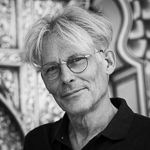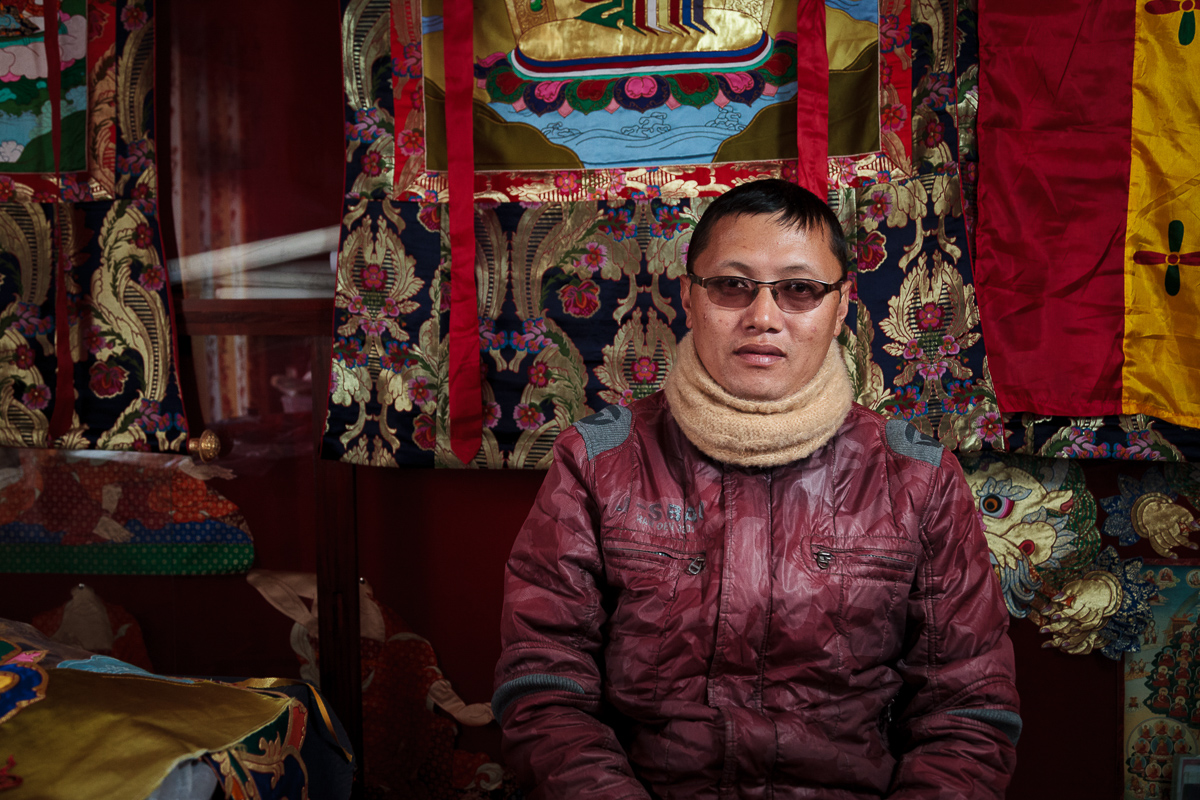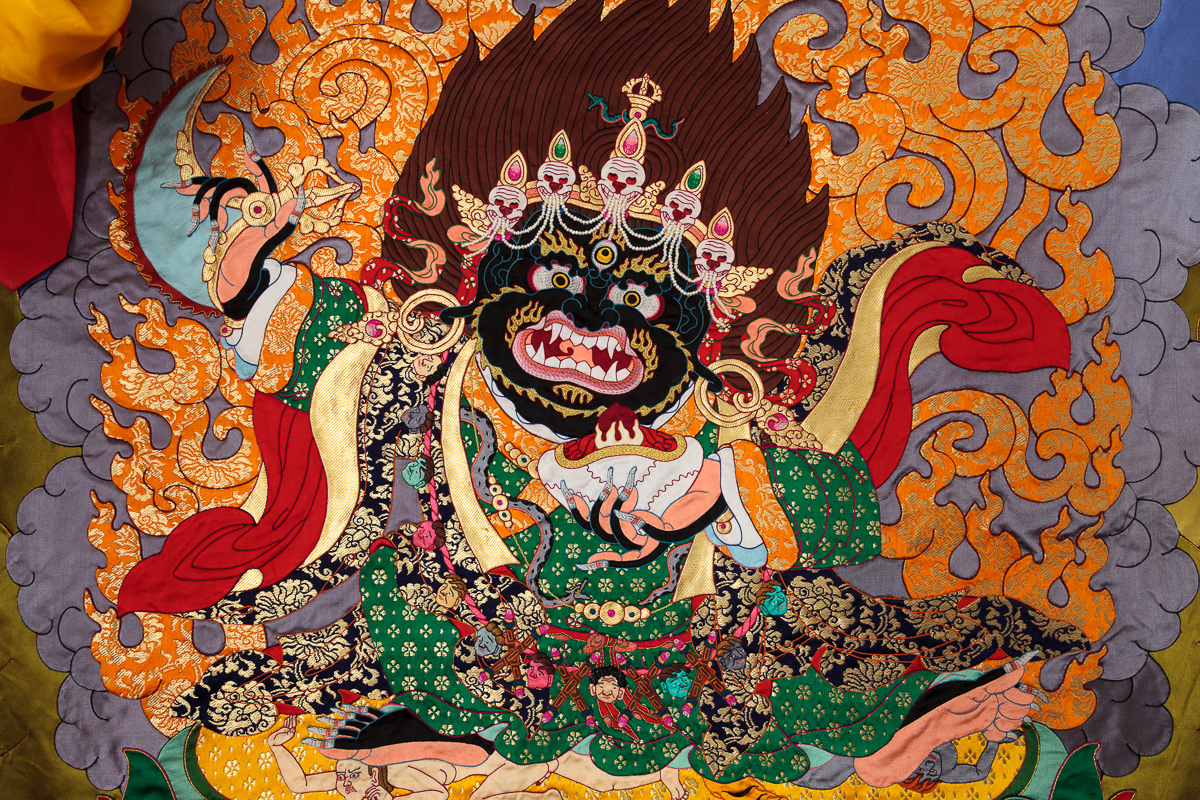Gary Wornell journeys to the Pullahari Gumba Monastery hoping to find Nurbu, whose life is dedicated to the tradition of sacred Buddhist imagery in luscious silk.
On an early December day a few years ago I arranged with two close friends, Anmol and Shailaja, to meet a craftsman making Buddhist Thangkas, in the hills to the north of Kathmandu, from sewn pieces of silk. I was very familiar with painted Thangkas. They are complex, detailed and highly intricate designs requiring extensive knowledge of the Buddhist scriptures and following precise proportions and renditions, copying the ancient versions with little deviation in colour or form. From the description, it sounded somewhere between quilting and applique. But with no images to reference online, I had no idea what I might find.
In those days, my preferred method of travel was by bicycle. Bicycling around Kathmandu is exhilarating, partly because of the city landscape and partly because it is an extreme sport of sorts requiring full concentration. Traffic is unpredictable and the roads can resemble rivers during the monsoon. They can have gaping holes that weren’t there yesterday or suddenly become a stage with hundreds of participants taking part in a celebration making passage nearly impossible.
My bicycle was in need of better brakes, a condition I had let get worse over time, and it wasn’t until I turned a corner down a narrow lane and collided head-on with a taxi that I decided it was now time to do something about them. Neither the taxi nor I sustained any damage beyond my acute embarrassment and the driver thought it somehow amusing. I picked myself up smiling into the gathering crowd, brushed the dust from my jeans, and rode off to my meeting.
We had arranged to meet with Sunny, a friend of the Thangka maker, at Boudhanath Stupa. He had kindly agreed to lead us up the hills to Norbu Lama Sherpa’s home and studio. I parked my bicycle and climbed onto the other motorbike for the journey up into the hills to the north. In those days the main gate of the Stupa was always busy with taxis, tourists, and Nepalis offering to guide, but after the start of the pandemic in 2020 tourism has all but dried up. Boudha is nevertheless packed with locals and Buddhist monks and nuns whatever the time of day and, in some ways, the place feels more authentic without the hustling vendors and shepherding tour guides.
Sunny had his mobile phone tucked into his helmet as he navigated through the traffic, taking calls as we wound around the lanes and climbed up the steep hill to Norbu’s workshop.
Sewn thangka is known as chenduma or kyigus in Tibetan and is a relatively new thing in Nepal. The oldest surviving Nepali thangkas date back to the early fourteenth-century. There is only one maker of sewn thangkas in the valley, and that is Norbu. He had first heard of this style at the age of 12 while living in his village in Sindhupalchok. Later he travelled to India and learned the skills from Finchu Tshiring, at Namchi Monastery where he studied the craft for three years. On his return, he moved to Kathmandu and soon established his own workshop.
The sounds from the monks and the horns and drums seemed to reach deep down into the soul, like a heartbeat out of time
The Pullahari Gumba Monastery on the top of the hill behind his house commissioned the first works. I had once gone with a friend, climbed the steep road by scooter and walked the last few hundred meters together through the lush green jungle to the clearing at the top. Young Buddhist novices in their burgundy robes were carrying buckets of water under the portico: cleaning the walkway and fooling around playfully with long-handled mops. The elegant simplicity of the building with its pillars and stone steps was enhanced with elaborately detailed frescos from the Buddhist scriptures. The haunting sound of dungchen horns and large drums were beginning in strange rhythms from inside and the boys suddenly disappeared.
We spent some time there, crept in through the main door, walked quietly along the edge of the room and settled on a bench against the wall, silent, absorbed, enchanted. The sounds from the monks and the horns and drums seemed to reach deep down into the soul, like a heartbeat out of time: the guttural voices chanting scriptures in long rambling phrases that never came to an end penetrated every thought in my mind as if there was nothing left to do in this world but breathe.
Like so many of the craftspeople I have met, Norbu lives in the same building where he works. Nepalis dress for the winter in thick down jackets and rarely take them off. Norbu had his on as he greeted us. It was a deep shiny burgundy like the colour of Buddhist robes and a texture not unlike the silk thangkas we were about to see. I felt handicapped not being able to converse in Nepali and spoke to him in English. He seemed to understand, but his answers were in Nepali and Shailaja translated. It was clear from his conversation that he is passionate about his work, enjoys the artistry and the material and wants to teach young people when he can. Norbu feels that the crafts are intrinsic to Nepali culture and should be kept alive. Soon we were up the stairs to the second floor entering a well-lit room equipped with an old treadle sewing machine, tables layered in exotic patches of patterned silks, cardboard boxes spread about, and a large glass-fronted cabinet, partly obscured by three large thangkas hanging from the top with their protective silk covers.

Old photographs form the starting point to creating the thangkas. The proportions are traditional and exact, but the colours can be interpreted by the crafts person with creative freedom of expression.
On the worktable in front of us was an old faded postcard-sized photograph of a thangka. Nurbu uses these as the starting point for his work, and while I was trying to make out the details, he and Sunny came over and set a large tracing of a Buddha, exquisitely drawn, on top of it. The drawing would form the basis for their next commission, and Nurbu explained that much of the work they do starts with small photographs they or their customers find here and there and using the geometric rules of form, they create the full-scale version by simply adding the known elements in the correct proportions. It all sounded quite easy the way he described it, but the freehand drawing on the table of the Buddha complete with beads, headpiece, earrings, bracelets, and urn was remarkable in its elegance of line and form.

Taking photographs is the last thing I want to do in situations like this. I’m torn between the moment of experience and the need to record what I’m seeing. One is often in conflict with the other. I take a few shots of the delicate tracing before it is whisked away and replaced by a plastic leafed photo album with snapshots of Norbu’s completed works. In one photo, a huge sewn thangka 52 feet in height cascades from the roof of a four-story monastery, dwarfing the monks in the grounds below. The sheer scale of the work is impressive.
Norbu has created a few of these. The big Bhaira he made for Jambala was the first work he made for a client. Later he went to nearby Pullahari, and the monks asked him for his study certificate. The certificate reassures the monks that he is qualified to carry out the work as well as being educated in Buddhist texts and iconography. He was commissioned to make a sewn thangka and soon other monasteries in the valley followed suit.
All of the textiles used here come from Varanasi in India, well known for its fine silks. Norbu goes regularly, commissions the designs he wants, selects the weight and finish and even orders the threads to be dyed to his own colours.
Back down on the ground floor three women were sitting huddled around a table on blue plastic garden chairs, heads down in concentration and sewing thin red piping to the edges of appliqué silk flowers. At another bench, a man was busy unrolling a two-meter length of monofilament fishing line from a spool. He tied a heavy weight to one end and let it hang over the edge of the table. To the other end, he tied a thread of red silk and clamped the knot in the jaws of a hand drill secured to the table. Turning the handle of the drill produced two meters of red piping in a matter of seconds. Tables were stacked with small pieces of silk stitched together, including feet, torsos, clouds, demons and religious motifs. Up here in the quiet hills above the city, the men and women continued their work, occasionally reaching across a table to get something, undisturbed by my presence, absorbed in their needles and threads.
Nurbu has offered the training for free
Norbu has taught everyone who works with him. They are paid according to their level of skill and can earn quite well when they reach a professional standard. He started by teaching his wife, then his son and then others followed. Now there are nine working here and nearly all the thangkas they make are made to commission. The new trainees go to college for their studies in the mornings and turn up to earn a living in the afternoons. Nurbu has offered the training for free and discovered at the same time a love of teaching, which brought him back to his village to work with men and women who wanted to learn the craft.
We have met a few times since my first visit. The thangka making virtually stopped for a year after the earthquakes of 2015. Norbu returned to his village in Sindhupalchok, one of the worst hit districts in Nepal, to help with the reconstruction and the rooms that once were used for silk thangka sewing had been converted to homes for people who had lost everything. In 2020, the lockdown caused by the COVID-19 pandemic had a much greater impact on his craft.
I knew he wasn’t at home and I was curious to find out more so I called him. We talked at length through a Tibetan interpreter. He had stopped work completely with the first lockdown in 2020 and sent his workers back to their villages where life was relatively undisturbed by the pandemic. With no access to silks imported from India, and no orders coming in from monasteries, he shut up shop and moved out of the city. Now, in late October 2021, life is beginning to return to normal again and in a week or so he plans to bring his team back to the city and start work.
The gates to Pullahari Monastery up behind Nurbu’s workshop also remained closed to visitors during the pandemic. The 250 monks and young novices stayed protected from the outside world for almost two years. It is a more monastic and isolated life than they were used to. From my apartment on the north-eastern edge of the city, I can hear the sounds of dungchen horns and drums and the chanting of monks and imagine, once again, the novices playing with their mops on the white marble steps before prayers. It won’t be long before I too can return, and see the silk thangkas of Norbu Lama Sherpa hanging on the walls of Pullahari.
Photos by Gary Wornell
Links to social media and websites
- Pullahari Monastery
- Facebook – Nurbu Lama Sherpa
About Gary Wornell
 Gary Wornell is an artist, photographer, film-maker, master print-maker, photojournalist, author and independent curator. A Canadian citizen, Gary has lived for extensive periods in the UK, Finland and Nepal. He divides his time between Finland and Nepal. In the last three years, he has worked as OECD-Finland-EU Social Protection Systems mobile device video trainer in Kyrgyzstan, Ethiopia, Cambodia and Zambia. He is currently active as design and marketing consultant to the Nepal infant clothing enterprise – Kokroma.com setting up their online shop, social media presence and developing production tools and methods for the clothing brand’s workshop in Kathmandu. He is book designer, photographer and author of Treasure of Nepal, Maahenki Finland 2016 – ISBN-10 9523010824 and designer Co-Author of Crafting a New Future for Nepal’s Traditional Artisans, PAF-The World Bank Group 2018 ISBN-9789937036511.
Gary Wornell is an artist, photographer, film-maker, master print-maker, photojournalist, author and independent curator. A Canadian citizen, Gary has lived for extensive periods in the UK, Finland and Nepal. He divides his time between Finland and Nepal. In the last three years, he has worked as OECD-Finland-EU Social Protection Systems mobile device video trainer in Kyrgyzstan, Ethiopia, Cambodia and Zambia. He is currently active as design and marketing consultant to the Nepal infant clothing enterprise – Kokroma.com setting up their online shop, social media presence and developing production tools and methods for the clothing brand’s workshop in Kathmandu. He is book designer, photographer and author of Treasure of Nepal, Maahenki Finland 2016 – ISBN-10 9523010824 and designer Co-Author of Crafting a New Future for Nepal’s Traditional Artisans, PAF-The World Bank Group 2018 ISBN-9789937036511.






